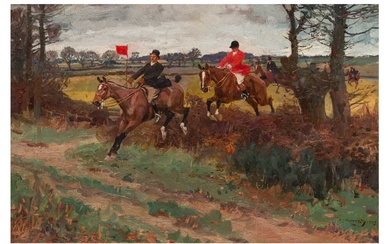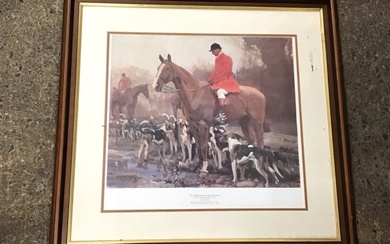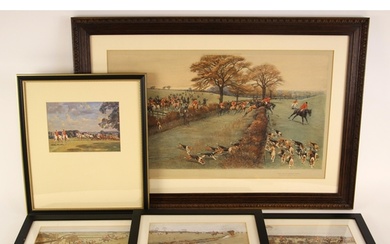Sir Alfred James Munnings, P.R.A., R.W.S., (British, 1878-1959)
Passing the barrow 16 1/4 x 24in (41.6 x 61cm)
Passing the barrow
signed 'A. J. Munnings.' (lower right)
oil on panel
16 1/4 x 24in (41.6 x 61cm)
Provenance
M. P. Williams;
with Frost & Reed, London;
Sale, Sotheby's, New York, 12 April 1996, lot 252;
Acquired from the above by the present owner.
Exhibited
London, Leicester Galleries, November 1947, no. 60.
During the 1940's and 1950's Munnings frequented Newmarket to paint various scenes involving racehorses. He particularly liked to experiment with the grouping of horses at exercise in the early mornings. The numerous strings of horses that went out each morning gave him endless motifs to study under different light conditions.
With a limited color pallete in the present work, Munnings has used the overcast light to focus on muted color values and tonal harmony. Even though the figures are sharply silhouetted against the background, the consistent greenish-grey hues throughout the scene make the horses very much part of the scene as a whole. The colors of the shadows and highlights on the figures are the same tones used to create the landscape, so every component of the scene relates to every other part.
The flat topography of East Anglia brings the moist air in from the sea and Munnings has captured this aspect of the area. With sweeping horizontal brushstrokes to depict the low cloud cover and moisture-laden sky, Munnings has evoked the dampness of the morning. The dark patches within the foreground grasses overlaid with wispy horizontal strokes of light pigment appear to be soggy areas or puddles that further suggests the damp air or prior rain shower.
Munnings was often concerned with the depiction of movement. Here he has arranged the horses so that they appear to be entering the scene, moving towards the empty space to the left. Optical theories reveal that our brain subconsciously fills that space with the horses as they walk left. Additionally, Munnings has added the ancient burial mound, slanting the diagonal angle left, furthering our perception of motion.
We are grateful to Lorian Peralta-Ramos for providing this catalogue note. The work will be included in her upcoming catalogue raisonné on the artist.
View it on
Sale price
Estimate
Time, Location
Auction House
Passing the barrow 16 1/4 x 24in (41.6 x 61cm)
Passing the barrow
signed 'A. J. Munnings.' (lower right)
oil on panel
16 1/4 x 24in (41.6 x 61cm)
Provenance
M. P. Williams;
with Frost & Reed, London;
Sale, Sotheby's, New York, 12 April 1996, lot 252;
Acquired from the above by the present owner.
Exhibited
London, Leicester Galleries, November 1947, no. 60.
During the 1940's and 1950's Munnings frequented Newmarket to paint various scenes involving racehorses. He particularly liked to experiment with the grouping of horses at exercise in the early mornings. The numerous strings of horses that went out each morning gave him endless motifs to study under different light conditions.
With a limited color pallete in the present work, Munnings has used the overcast light to focus on muted color values and tonal harmony. Even though the figures are sharply silhouetted against the background, the consistent greenish-grey hues throughout the scene make the horses very much part of the scene as a whole. The colors of the shadows and highlights on the figures are the same tones used to create the landscape, so every component of the scene relates to every other part.
The flat topography of East Anglia brings the moist air in from the sea and Munnings has captured this aspect of the area. With sweeping horizontal brushstrokes to depict the low cloud cover and moisture-laden sky, Munnings has evoked the dampness of the morning. The dark patches within the foreground grasses overlaid with wispy horizontal strokes of light pigment appear to be soggy areas or puddles that further suggests the damp air or prior rain shower.
Munnings was often concerned with the depiction of movement. Here he has arranged the horses so that they appear to be entering the scene, moving towards the empty space to the left. Optical theories reveal that our brain subconsciously fills that space with the horses as they walk left. Additionally, Munnings has added the ancient burial mound, slanting the diagonal angle left, furthering our perception of motion.
We are grateful to Lorian Peralta-Ramos for providing this catalogue note. The work will be included in her upcoming catalogue raisonné on the artist.







